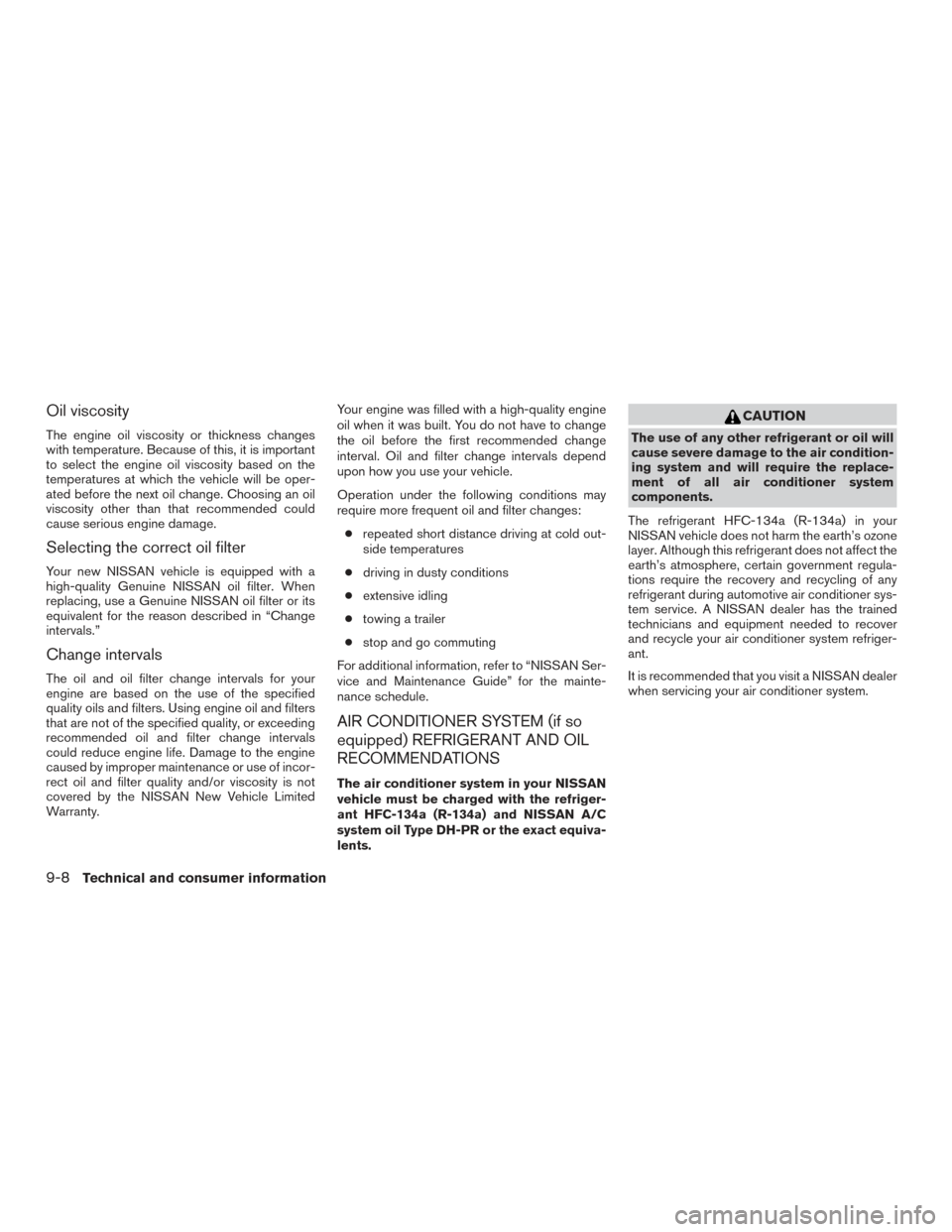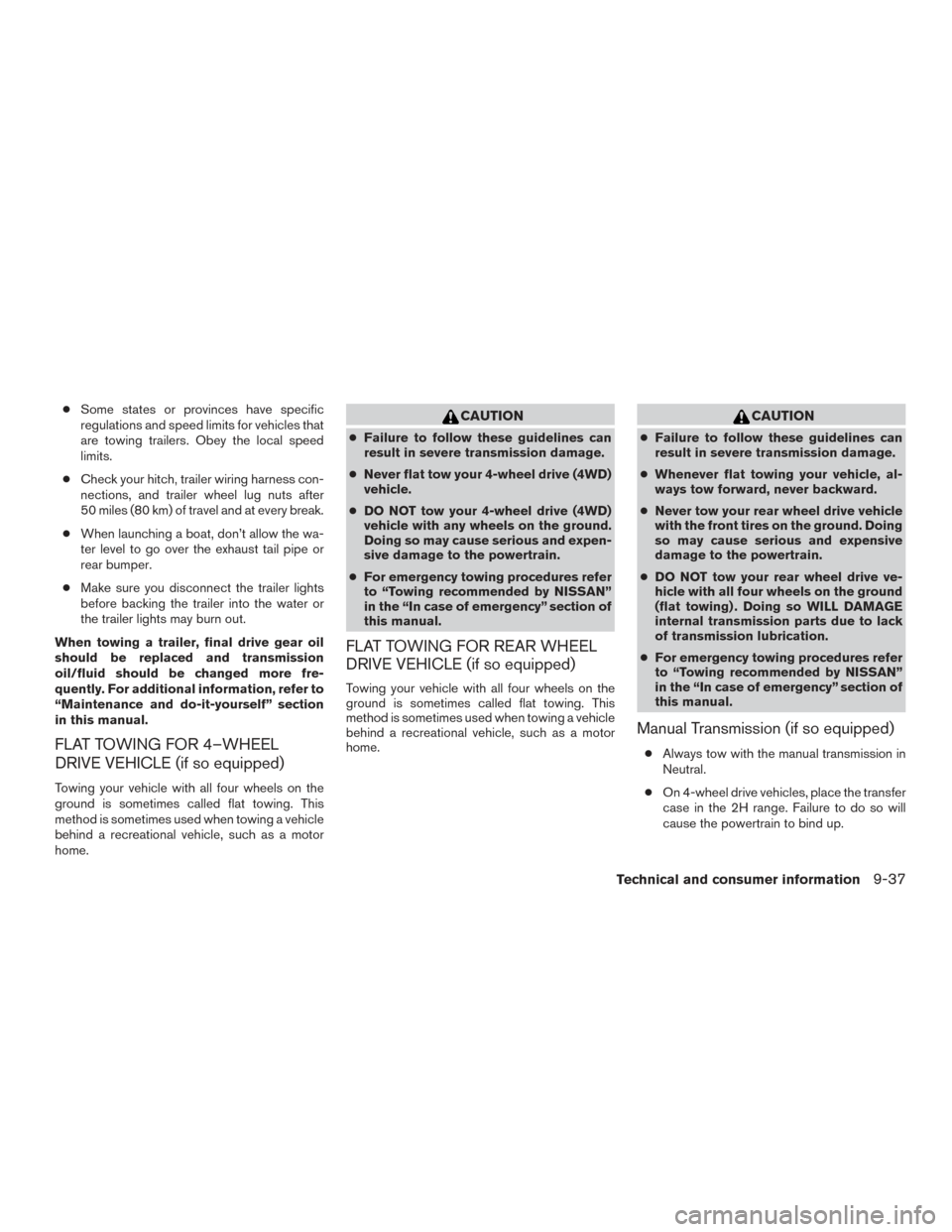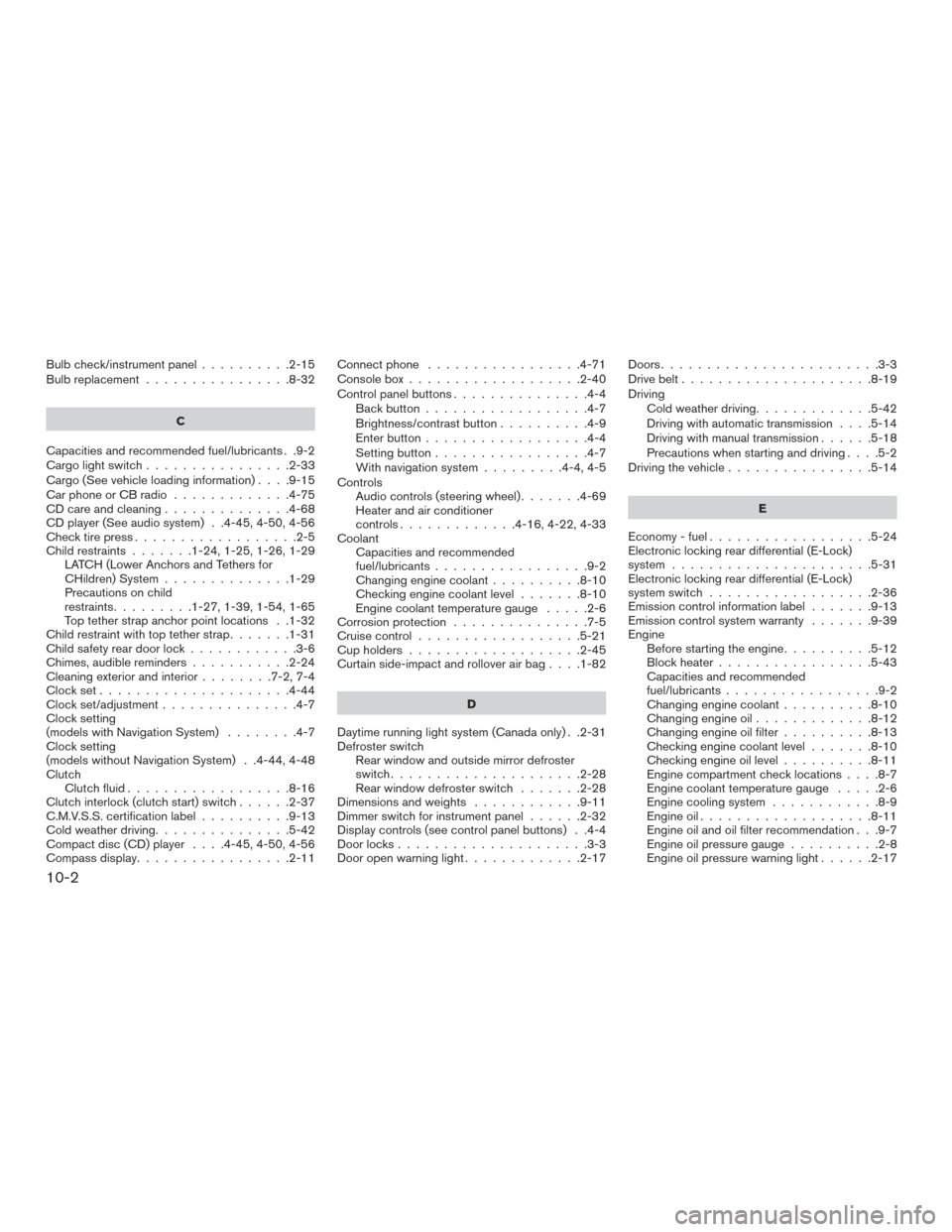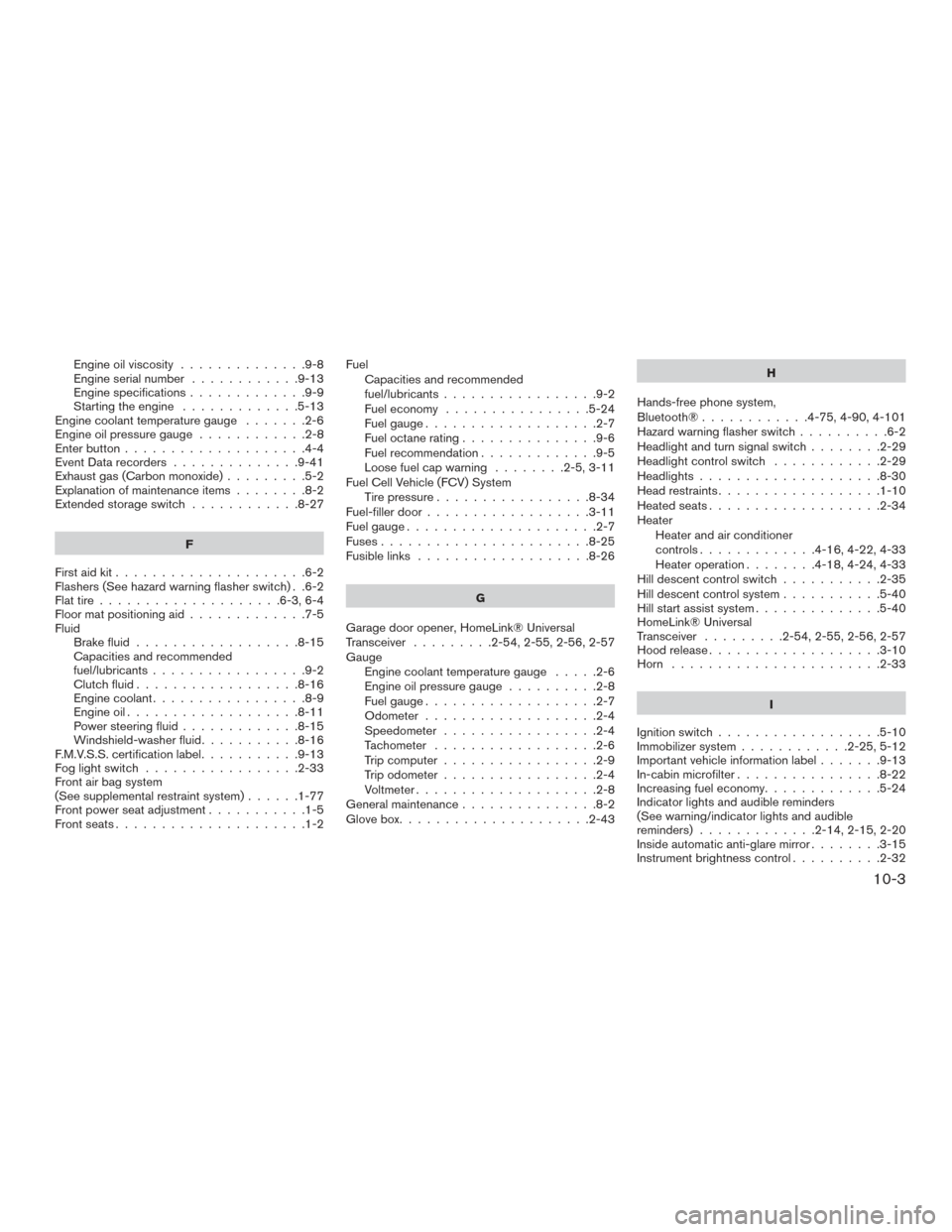2016 NISSAN FRONTIER recommended oil
[x] Cancel search: recommended oilPage 425 of 469

Oil viscosity
The engine oil viscosity or thickness changes
with temperature. Because of this, it is important
to select the engine oil viscosity based on the
temperatures at which the vehicle will be oper-
ated before the next oil change. Choosing an oil
viscosity other than that recommended could
cause serious engine damage.
Selecting the correct oil filter
Your new NISSAN vehicle is equipped with a
high-quality Genuine NISSAN oil filter. When
replacing, use a Genuine NISSAN oil filter or its
equivalent for the reason described in “Change
intervals.”
Change intervals
The oil and oil filter change intervals for your
engine are based on the use of the specified
quality oils and filters. Using engine oil and filters
that are not of the specified quality, or exceeding
recommended oil and filter change intervals
could reduce engine life. Damage to the engine
caused by improper maintenance or use of incor-
rect oil and filter quality and/or viscosity is not
covered by the NISSAN New Vehicle Limited
Warranty.Your engine was filled with a high-quality engine
oil when it was built. You do not have to change
the oil before the first recommended change
interval. Oil and filter change intervals depend
upon how you use your vehicle.
Operation under the following conditions may
require more frequent oil and filter changes:
● repeated short distance driving at cold out-
side temperatures
● driving in dusty conditions
● extensive idling
● towing a trailer
● stop and go commuting
For additional information, refer to “NISSAN Ser-
vice and Maintenance Guide” for the mainte-
nance schedule.
AIR CONDITIONER SYSTEM (if so
equipped) REFRIGERANT AND OIL
RECOMMENDATIONS
The air conditioner system in your NISSAN
vehicle must be charged with the refriger-
ant HFC-134a (R-134a) and NISSAN A/C
system oil Type DH-PR or the exact equiva-
lents.
CAUTION
The use of any other refrigerant or oil will
cause severe damage to the air condition-
ing system and will require the replace-
ment of all air conditioner system
components.
The refrigerant HFC-134a (R-134a) in your
NISSAN vehicle does not harm the earth’s ozone
layer. Although this refrigerant does not affect the
earth’s atmosphere, certain government regula-
tions require the recovery and recycling of any
refrigerant during automotive air conditioner sys-
tem service. A NISSAN dealer has the trained
technicians and equipment needed to recover
and recycle your air conditioner system refriger-
ant.
It is recommended that you visit a NISSAN dealer
when servicing your air conditioner system.
9-8Technical and consumer information
Page 454 of 469

●Some states or provinces have specific
regulations and speed limits for vehicles that
are towing trailers. Obey the local speed
limits.
● Check your hitch, trailer wiring harness con-
nections, and trailer wheel lug nuts after
50 miles (80 km) of travel and at every break.
● When launching a boat, don’t allow the wa-
ter level to go over the exhaust tail pipe or
rear bumper.
● Make sure you disconnect the trailer lights
before backing the trailer into the water or
the trailer lights may burn out.
When towing a trailer, final drive gear oil
should be replaced and transmission
oil/fluid should be changed more fre-
quently. For additional information, refer to
“Maintenance and do-it-yourself” section
in this manual.
FLAT TOWING FOR 4–WHEEL
DRIVE VEHICLE (if so equipped)
Towing your vehicle with all four wheels on the
ground is sometimes called flat towing. This
method is sometimes used when towing a vehicle
behind a recreational vehicle, such as a motor
home.
CAUTION
● Failure to follow these guidelines can
result in severe transmission damage.
● Never flat tow your 4-wheel drive (4WD)
vehicle.
● DO NOT tow your 4-wheel drive (4WD)
vehicle with any wheels on the ground.
Doing so may cause serious and expen-
sive damage to the powertrain.
● For emergency towing procedures refer
to “Towing recommended by NISSAN”
in the “In case of emergency” section of
this manual.
FLAT TOWING FOR REAR WHEEL
DRIVE VEHICLE (if so equipped)
Towing your vehicle with all four wheels on the
ground is sometimes called flat towing. This
method is sometimes used when towing a vehicle
behind a recreational vehicle, such as a motor
home.
CAUTION
●Failure to follow these guidelines can
result in severe transmission damage.
● Whenever flat towing your vehicle, al-
ways tow forward, never backward.
● Never tow your rear wheel drive vehicle
with the front tires on the ground. Doing
so may cause serious and expensive
damage to the powertrain.
● DO NOT tow your rear wheel drive ve-
hicle with all four wheels on the ground
(flat towing) . Doing so WILL DAMAGE
internal transmission parts due to lack
of transmission lubrication.
● For emergency towing procedures refer
to “Towing recommended by NISSAN”
in the “In case of emergency” section of
this manual.
Manual Transmission (if so equipped)
● Always tow with the manual transmission in
Neutral.
● On 4-wheel drive vehicles, place the transfer
case in the 2H range. Failure to do so will
cause the powertrain to bind up.
Technical and consumer information9-37
Page 461 of 469

Bulb check/instrument panel..........2-15
Bulb replacement ................8-32
C
Capacities and recommended fuel/lubricants . .9-2
Cargolightswitch................2-33
Cargo(Seevehicleloadinginformation)....9-15
Car phone or CB radio .............4-75
CD care and cleaning ..............4-68
CD player (See audio system) . .4-45, 4-50, 4-56
Check tire press ..................2-5
Child restraints .......1-24,1-25,1-26,1-29
LATCH (Lower Anchors and Tethers for
CHildren) System ..............1-29
Precautions on child
restraints.........1-27,1-39,1-54,1-65
Top tether strap anchor point locations . .1-32
Child restraint with top tether strap .......1-31
Child safety rear door lock ............3-6
Chimes, audible reminders ...........2-24
Cleaningexteriorandinterior........7-2,7-4
Clockset.....................4-44
Clock set/adjustment ...............4-7
Clock setting
(models with Navigation System) ........4-7
Clock setting
(models without Navigation System) . .4-44, 4-48
Clutch Clutch fluid ..................8-16
Clutch interlock (clutch start) switch ......2-37
C.M.V.S.S. certification label ..........9-13
Cold weather driving ...............5-42
Compact disc (CD) player ....4-45,4-50,4-56
Compass display .................2-11 Connect phone
.................4-71
Console box ...................2-40
Control panel buttons ...............4-4
Back button ..................4-7
Brightness/contrast button ..........4-9
Enterbutton..................4-4
Setting button .................4-7
With navigation system .........4-4,4-5
Controls Audio controls (steering wheel) .......4-69
Heater and air conditioner
controls.............4-16,4-22,4-33
Coolant Capacities and recommended
fuel/lubricants .................9-2
Changingenginecoolant..........8-10
Checking engine coolant level .......8-10
Engine coolant temperature gauge .....2-6
Corrosion protection ...............7-5
Cruisecontrol..................5-21
Cupholders...................2-45
Curtainside-impactandrolloverairbag....1-82
D
Daytime running light system (Canada only) . .2-31
Defroster switch Rear window and outside mirror defroster
switch.....................2-28
Rear window defroster switch .......2-28
Dimensionsandweights ............9-11
Dimmer switch for instrument panel ......2-32
Display controls (see control panel buttons) . .4-4
Door locks .....................3-3
Door open warning light .............2-17 Doors
........................3-3
Drive belt .....................8-19
Driving Cold weather driving .............5-42
Driving with automatic transmission ....5-14
Driving with manual transmission ......5-18
Precautions when starting and driving ....5-2
Driving the vehicle ................5-14
E
Economy-fuel..................5-24
Electronic locking rear differential (E-Lock)
system ......................5-31
Electronic locking rear differential (E-Lock)
system switch ..................2-36
Emission control information label .......9-13
Emission control
system warranty .......9-39
Engine Before starting the engine ..........5-12
Blockheater.................5-43
Capacities and recommended
fuel/lubricants.................9-2
Changing engine coolant ..........8-10
Changingengineoil.............8-12
Changing engine oil filter ..........8-13
Checking engine coolant level .......8-10
Checking engine oil level ..........8-11
Engine compartment check locations ....8-7
Engine coolant temperature gauge .....2-6
Engine cooling system ............8-9
Engineoil...................8-11
Engine oil and oil filter recommendation . . .9-7
Engineoilpressuregauge..........2-8
Engine oil pressure warning light ......2-17
10-2
Page 462 of 469

Engine oil viscosity..............9-8
Engine serial number ............9-13
Engine specifications .............9-9
Starting the engine .............5-13
Engine coolant temperature gauge .......2-6
Engineoilpressuregauge............2-8
Enterbutton....................4-4
Event Data recorders ..............9-41
Exhaust gas (Carbon monoxide) .........5-2
Explanation of maintenance items ........8-2
Extendedstorageswitch ............8-27
F
First aid kit .....................6-2
Flashers (See hazard warning flasher switch) . .6-2
Flat tire ....................6-3,6-4
Floor mat positioning aid .............7-5
Fluid Brake fluid ..................8-15
Capacities and recommended
fuel/lubricants .................9-2
Clutchfluid..................8-16
Engine coolant .................8-9
Engine oil ...................8-11
Power steering fluid .............8-15
Windshield-washerfluid...........8-16
F.M.V.S.S. certification label ...........9-13
Foglightswitch .................2-33
Front air bag system
(See supplemental restraint system) ......1-77
Front power seat adjustment ...........1-5
Frontseats.....................1-2 Fuel
Capacities and recommended
fuel/lubricants .................9-2
Fuel economy ................5-24
Fuel gauge ...................2-7
Fuel octane rating ...............9-6
Fuel recommendation .............9-5
Loose fuel cap warning ........2-5,3-11
Fuel Cell Vehicle (FCV) System Tirepressure.................8-34
Fuel-filler door ..................3-11
Fuelgauge.....................2-7
Fuses.......................8-25
Fusiblelinks ...................8-26
G
Garage door opener, HomeLink® Universal
Transceiver .........2-54,2-55,2-56,2-57
Gauge Engine coolant temperature gauge .....2-6
Engine oil pressure gauge ..........2-8
Fuel gauge ...................2-7
Odometer ...................2-4
Speedometer .................2-4
Tachometer ..................2-6
Trip computer .................2-9
Trip odometer .................2-4
Voltmeter....................2-8
General maintenance ...............8-2
Glovebox.....................2-43 H
Hands-free phone system,
Bluetooth®............4-75,4-90,4-101
Hazard warning flasher switch ..........6-2
Headlightandturnsignalswitch........2-29
Headlightcontrolswitch ............2-29
Headlights....................8-30
Head restraints ..................1-10
Heated seats ...................2-34
Heater Heater and air conditioner
controls .............4-16,4-22,4-33
Heater operation ........4-18,4-24,4-33
Hill descent control switch ...........2-35
Hill descent control system ...........
5
-40
Hill start assist system ..............5-40
HomeLink® Universal
Transceiver .........2-54,2-55,2-56,2-57
Hoodrelease...................3-10
Horn .......................2-33
I
Ignition switch ..................5-10
Immobilizer system ............2-25,5-12
Important vehicle information label .......9-13
In-cabin microfilter ................8-22
Increasing fuel economy .............5-24
Indicator lights and audible reminders
(See warning/indicator lights and audible
reminders).............2-14,2-15,2-20
Inside automatic anti-glare mirror ........3-15
Instrument brightness control ..........2-32
10-3
Page 464 of 469

O
Octanerating(Seefueloctanerating)......9-6
Odometer .....................2-4
Oil Capacities and recommended
fuel/lubricants .................9-2
Changing engine oil .............8-12
Changing engine oil filter ..........8-13
Checking engine oil level ..........8-11
Engine oil ...................8-11
Engine oil and oil filter recommendation . . .9-7
Engine oil viscosity ..............9-8
Oneshotcall...........4-79,4-93,4-103
Outside mirrors .................3-16
Overdrive switch .................5-17
Overheat Ifyourvehicleoverheats...........6-13
Owner’s manual order form ...........9-41
Owner’s manual/service manual order
information ....................9-41
P
Parking Parking brake operation ...........5-20
Parking/parking on hills ...........5-33
Phone, Bluetooth® hands-free
system ...............4-75,4-90,4-101
Power Front seat adjustment .............1-5
Power door locks ...............3-4
Power outlet .................2-38
Power steering fluid .............8-15 Power steering system
...........5-34
Power windows ...............2-48
Rear power windows ............2-50
Power outlet ...................2-38
Power steering ..................5-34
Power steering fluid ...............8-15
Precautions Maintenance precautions ...........8-5
On-pavement and off-road driving
precautions ..................5-6
Precautions on booster
seats...........1-27,1-39,1-54,1-65
Precautions on child
restraints .........1-27,1-39,1-54,1-65
Precautions on seat belt usage .......1-15
Precautions on supplemental restraint
system ....................1-70
Precautions when starting and driving ....5-2
Programmablefeatures..............4-7
Push starting ...................6-13
R
Radio Car phone or CB radio ...........4-75
FM-AM radio with compact disc (CD)
player .....................4-43
FM/AM/SAT radio with compact disc (CD)
player .................4-47,4-51
Steering wheel audio control switch ....4-69
Readiness for inspection maintenance (I/M)
test........................9-40
Rear power windows ..............2-50
Rearseat......................1-6
Rear sliding window ...............2-51 Rear sonar system
................5-41
Rear sonar system off switch ..........2-38
Rearview mirror .................3-15
RearView Monitor ................4-10
Rear window and outside mirror defroster
switch.......................2-28
Rear window defroster switch .........2-28
Recommended Fluids ...............9-2
Recorders EventData..................9-41
Refrigerant recommendation ...........
9-8
Registering a vehicle in another country ....9-12
Remote keyless entry system ........3-6,3-7
Reporting safety defects (US only) .......9-39
Roof rack .....................2-47
S
Safety Child safety rear door lock ..........3-6
Child seat belts .....1-27,1-39,1-54,1-65
Reporting safety defects (US only) .....9-39
Seat Jumpseat ...................1-7
Seat adjustment Front manual seat adjustment ........1-3
Front power seat adjustment .........1-5
Seatbackpockets................2-45
Seat belt Child safety ..................1-24
Infants and small children ..........1-25
Injured Person ................1-18
Largerchildren................1-25
Precautions on seat belt usage .......1-15
Pregnant women ...............1-18
10-5
Page 468 of 469

FUEL RECOMMENDATION:
Use unleaded regular gasoline with an octane
rating of at least 87 AKI (Anti-Knock Index) num-
ber (Research octane number 91) .
CAUTION
●Using a fuel other than that specified
could adversely affect the emission
control system, and may also affect the
warranty coverage.
● Under no circumstances should a
leaded gasoline be used, because this
will damage the three-way catalyst.
● Do not use E-15 or E-85 fuel in your
vehicle. Your vehicle is not designed to
run on E-15 or E-85 fuel. Using E-15 or
E-85 fuel in a vehicle not specifically
designed for E-15 or E-85 fuel can ad-
versely affect the emission control de-
vices and systems of the vehicle. Dam-
age caused by such fuel is not covered
by the NISSAN New Vehicle Limited
Warranty. ●
Do not use fuel that contains the octane
booster methylcyclopentadienyl man-
ganese tricarbonyl (MMT) . Using fuel
containing MMT may adversely affect
vehicle performance and vehicle emis-
sions. Not all fuel dispensers are la-
beled to indicate MMT content, so you
may have to consult your gasoline re-
tailer for more details. Note that Fed-
eral and California laws prohibit the use
of MMT in reformulated gasoline.
● U.S. government regulations require
ethanol dispensing pumps to be identi-
fied by a small, square, orange and
black label with the common abbrevia-
tion or the appropriate percentage for
that region.
For additional information, refer to “Recom-
mended fluids/lubricants and capacities” in the
“Technical and consumer information” section of
this manual.
ENGINE OIL RECOMMENDATION:
● Genuine NISSAN engine oil or equivalent
● Engine oil with API Certification Mark, Vis-
cosity SAE 5W-30 For additional information, refer to “Engine oil and
oil filter recommendations” in the “Technical and
consumer information” section of this manual.
COLD TIRE PRESSURE:
For additional information, refer to “Tire and load-
ing information label” in the “Technical and con-
sumer information” section of this manual.
The label is typically located on the driver side
center pillar or on the driver’s door. For additional
information, refer to “Wheels and tires” in the
“Maintenance and do-it-yourself” section of this
manual.
RECOMMENDED NEW VEHICLE
BREAK-IN PROCEDURE:
During the first 1,200 miles (2,000 km) of vehicle
use, follow the break-in procedure recommenda-
tions for the future reliability and economy of your
new vehicle. For additional information, refer to
“Break-in schedule” in the “Starting and driving”
section of this manual. Failure to follow these
recommendations may result in vehicle damage
or shortened engine life.
GAS STATION INFORMATION